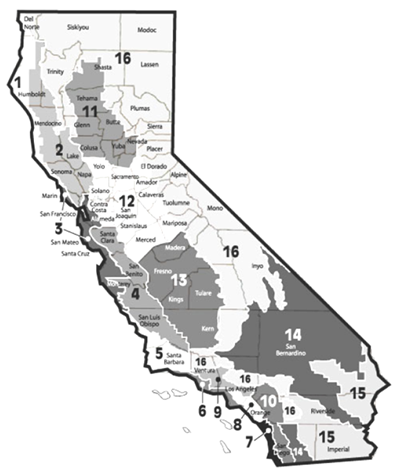
Section 25402 of the Public Resources Code
The Legislature adopted the Warren-Alquist Act (the Act) which created the Energy Resources and Conservation Development Commission (Energy Commission) in 1975 to deal with energy-related issues, and charged the Energy Commission to adopt and maintain Energy Efficiency Standards for new buildings. The first standards were adopted in 1978 in the aftermath of the Organization of Petroleum Exporting Countries (OPEC) oil embargo of 1973.
The Act requires that the Energy Standards be cost effective “when taken in their entirety and amortized over the economic life of the structure.”
The Energy Commission is required to periodically update the standards. Six months before the effective date of new standards, manuals must be published to support the Energy Standards. The Act directs local building permit jurisdictions to withhold permits until the building satisfies the standards.
The first generation standards for nonresidential buildings took effect in 1978, and remained in effect for all nonresidential occupancies until the late 1980s. That is when the second generation standards took effect for offices, retail, and wholesale stores.
The next major revision occurred in 1992 when the requirements were simplified and consolidated for all building types. Major changes were made to lighting, building envelope, fenestration, and HVAC and mechanical requirements. Structural changes made in1992 led the way for national standards in other states.
The standards went through minor revisions in 1995. In 1998, lighting power limits were reduced significantly, because electronic ballasts and T-8 lamps were cost effective and becoming common practice in nonresidential buildings.
The California electricity crisis of 2000 resulted in rolling blackouts through much of the state. This produced escalating energy prices at the wholesale market and in some areas in the retail market. The Legislature responded with Assembly Bill 970, which required the Energy Commission to update the Energy Standards through an emergency rulemaking. This was achieved within the 120 days required by the Legislature. The2001 Standards (or the AB 970 Standards) took effect mid-2001. The 2001 Standards included requirements for high performance windows throughout California, more stringent lighting requirements and miscellaneous other changes.
The Public Resources Code was amended in 2002 through Senate Bill 5X to expand the authority of the Energy Commission to develop and maintain standards for outdoor lighting and signs. The Energy Standards covered in this manual build on the rich history of Nonresidential Energy Standards in California and the leadership and direction provided by the California Legislature over the years.
The 2008 Standards were expanded to include refrigerated warehouses and steep-sloped roofs.
The 2013 Energy Standards reflected many significant changes and expanded its scope. Some changes included fault detection and diagnostic devices, economizer damper leakage and assembly criteria, air handler fan control for HVAC systems, updates to the low-sloped cool roofs requirements for nonresidential buildings, and for the first time, set minimum mandatory measures for insulation in nonresidential buildings. Expanding the scope of the standards included newly regulated covered processes such as: parking garage ventilation, process boiler systems, compressed air systems, commercial refrigeration, laboratory exhaust, data center (computer room) HVAC, and commercial kitchens.
The 2016 Energy Standards are current with ASHRAE 90.1 national consensus standards. Changes were made to clarify the Energy Standards and resolve compliance concerns.
Example 1-17
Question
Does LEED-certified building still need to meet the 2016 Energy Standards?
Answer
Yes.
Since energy use depends partly upon weather conditions, the Energy Commission established 16 climate zones representing distinct climates within California. These 16 climate zones are used with both residential and the nonresidential standards. Information is available by zip code and in several formats (http://energy.ca.gov/maps/renewable/building_climate_zones.html).
Cities may occasionally straddle two climate zones. In these instances, the exact building location and correct climate zone should be verified before any calculations are performed. If a climate zone boundary line splits a single building, it must be designed to the requirements of the climate zone in which 50 percent or more of the building is contained.
Figure 1-1: California Climate Zones
